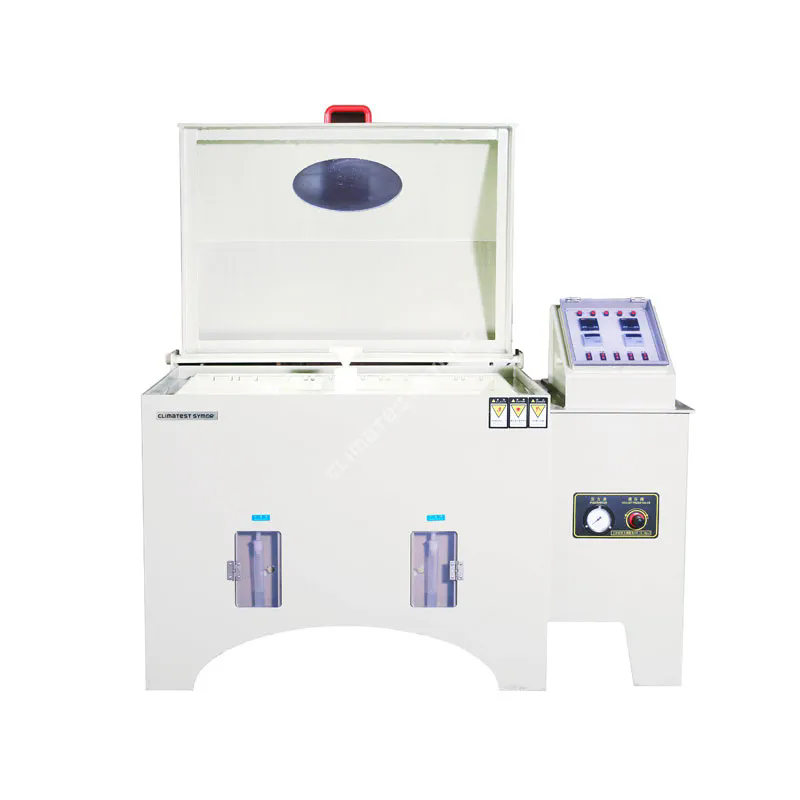Salt Spray Test Chamber: Essential Equipment for Assessing Corrosion Resistance
2024-08-07
A Salt Spray Test Chamber is a crucial piece of equipment used to evaluate the corrosion resistance of materials and coatings. This testing method simulates harsh environmental conditions to predict how materials will withstand prolonged exposure to saline environments, such as those found in coastal regions or industrial settings. In this blog, we'll delve into the features, benefits, and applications of Salt Spray Test Chambers and their role in quality assurance and material performance testing.
1. What is a Salt Spray Test Chamber?
A Salt Spray Test Chamber is a controlled environment chamber designed to conduct salt spray (or salt fog) testing. This test involves exposing materials, coatings, or products to a salt-laden mist under specific temperature and humidity conditions to assess their resistance to corrosion.
Key Components:
- Chamber Interior: The test chamber where samples are placed and exposed to the salt spray. It is usually constructed from corrosion-resistant materials.
- Salt Spray Generator: An apparatus that produces a fine mist of salt solution (typically sodium chloride) and disperses it into the chamber.
- Control System: Includes temperature, humidity, and spray rate controls to ensure precise testing conditions.
- Sample Holders: Racks or fixtures used to securely hold the test samples during the exposure period.
2. Features of Salt Spray Test Chambers
- Controlled Environment: Allows for precise control over temperature, humidity, and spray intensity to simulate various corrosive environments.
- Versatile Testing: Suitable for testing a wide range of materials, including metals, coatings, paints, and plastic components.
- Long-Term Testing: Capable of running extended tests to evaluate how materials perform over prolonged exposure periods.
- Compliance with Standards: Designed to meet industry standards and specifications, such as ASTM B117 and ISO 9227, for consistent and reliable results.
- User-Friendly Interface: Modern chambers often feature digital controls and automated systems for ease of operation and monitoring.
3. Benefits of Using a Salt Spray Test Chamber
- Predicts Material Durability: Helps manufacturers and researchers understand how materials and coatings will perform in real-world, corrosive environments, improving product longevity and reliability.
- Ensures Quality Control: Provides a means to verify that materials and coatings meet quality standards and specifications before they are used in production or distributed.
- Enhances Product Development: Assists in the development and optimization of corrosion-resistant materials and coatings by providing valuable performance data.
- Reduces Risk: Identifies potential issues with corrosion resistance early in the design and manufacturing process, reducing the risk of product failure and associated costs.
- Regulatory Compliance: Supports compliance with industry standards and regulations by providing documented evidence of corrosion resistance.
4. Applications of Salt Spray Test Chambers
- Automotive Industry: Used to test the corrosion resistance of automotive parts and coatings, ensuring durability and performance in various environmental conditions.
- Aerospace Industry: Assesses the performance of aircraft components and coatings subjected to harsh atmospheric conditions.
- Construction: Evaluates the corrosion resistance of building materials and coatings used in outdoor or coastal applications.
- Consumer Goods: Tests products such as electronics, appliances, and hardware to ensure they can withstand exposure to corrosive environments.
- Marine Industry: Ensures that components and coatings used in marine applications, such as boats and offshore structures, are resistant to saltwater corrosion.
- Industrial Equipment: Assesses the durability of industrial machinery and equipment exposed to corrosive substances in manufacturing environments.
5. Conducting a Salt Spray Test
- Preparation: Prepare the test samples according to the relevant standards and place them in the chamber. Ensure that the chamber is clean and set up correctly.
- Testing Conditions: Set the chamber to the required temperature, humidity, and spray rate as specified by the testing standard.
- Exposure: Run the test for the specified duration, which can range from hours to several weeks, depending on the material and testing requirements.
- Inspection: After the test period, inspect the samples for signs of corrosion, such as rust, degradation, or coating failure.
- Documentation: Record the test conditions, duration, and observed results to provide detailed documentation for analysis and reporting.
6. Considerations for Choosing a Salt Spray Test Chamber
- Size and Capacity: Select a chamber size that accommodates the scale of testing required for your samples.
- Control Precision: Ensure the chamber offers precise control over environmental parameters to meet specific testing standards.
- Compliance: Verify that the chamber complies with relevant industry standards and regulations for accurate and reliable testing.
- Maintenance and Support: Choose a chamber from a reputable manufacturer that offers reliable maintenance and technical support services.
Conclusion
The Salt Spray Test Chamber is an essential tool for assessing the corrosion resistance of materials and coatings, providing valuable insights into their performance under harsh environmental conditions. By simulating the effects of salt exposure, this equipment helps manufacturers, researchers, and quality control professionals ensure the durability and reliability of their products. Whether used in automotive, aerospace, construction, or consumer goods industries, the Salt Spray Test Chamber plays a crucial role in maintaining high standards of quality and performance. Understanding its features, benefits, and applications can help organizations make informed decisions and enhance their product development and quality assurance processes.



